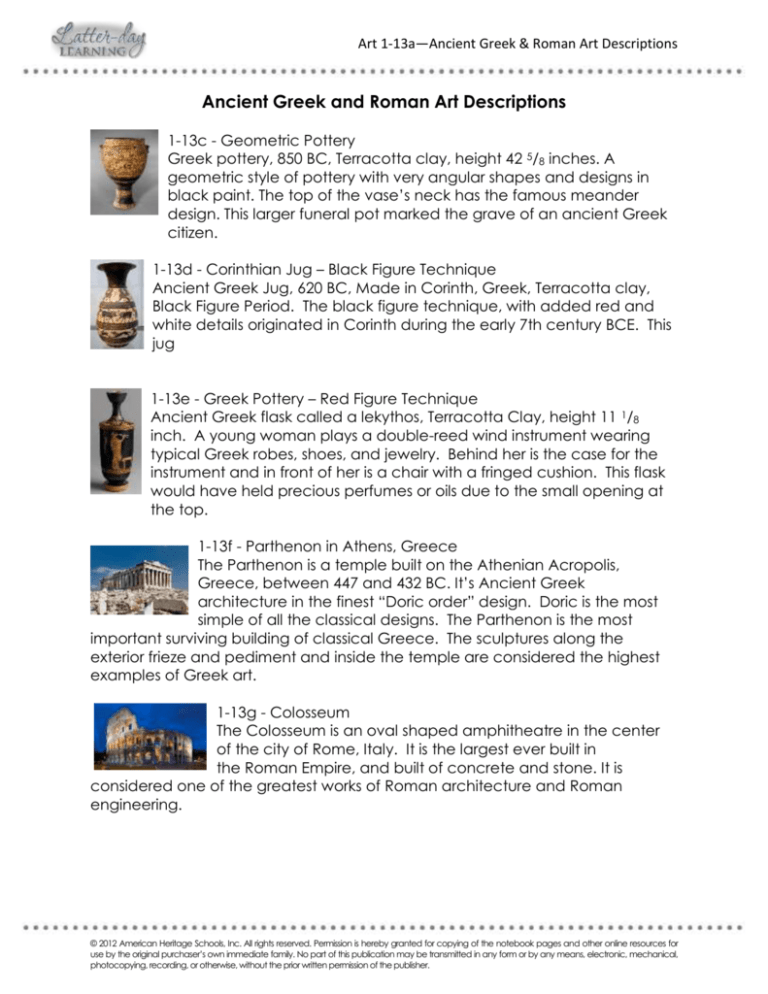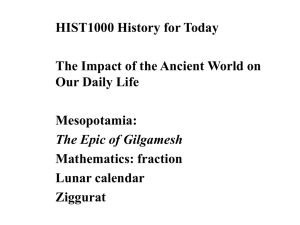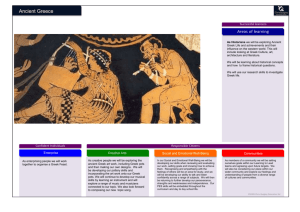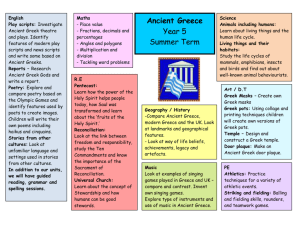
Art 1-13a—Ancient Greek & Roman Art Descriptions
Ancient Greek and Roman Art Descriptions
1-13c - Geometric Pottery
Greek pottery, 850 BC, Terracotta clay, height 42 5/8 inches. A
geometric style of pottery with very angular shapes and designs in
black paint. The top of the vase’s neck has the famous meander
design. This larger funeral pot marked the grave of an ancient Greek
citizen.
1-13d - Corinthian Jug – Black Figure Technique
Ancient Greek Jug, 620 BC, Made in Corinth, Greek, Terracotta clay,
Black Figure Period. The black figure technique, with added red and
white details originated in Corinth during the early 7th century BCE. This
jug
1-13e - Greek Pottery – Red Figure Technique
Ancient Greek flask called a lekythos, Terracotta Clay, height 11 1/8
inch. A young woman plays a double-reed wind instrument wearing
typical Greek robes, shoes, and jewelry. Behind her is the case for the
instrument and in front of her is a chair with a fringed cushion. This flask
would have held precious perfumes or oils due to the small opening at
the top.
1-13f - Parthenon in Athens, Greece
The Parthenon is a temple built on the Athenian Acropolis,
Greece, between 447 and 432 BC. It’s Ancient Greek
architecture in the finest “Doric order” design. Doric is the most
simple of all the classical designs. The Parthenon is the most
important surviving building of classical Greece. The sculptures along the
exterior frieze and pediment and inside the temple are considered the highest
examples of Greek art.
1-13g - Colosseum
The Colosseum is an oval shaped amphitheatre in the center
of the city of Rome, Italy. It is the largest ever built in
the Roman Empire, and built of concrete and stone. It is
considered one of the greatest works of Roman architecture and Roman
engineering.
© 2012 American Heritage Schools, Inc. All rights reserved. Permission is hereby granted for copying of the notebook pages and other online resources for
use by the original purchaser’s own immediate family. No part of this publication may be transmitted in any form or by any means, electronic, mechanical,
photocopying, recording, or otherwise, without the prior written permission of the publisher.
Art 1-13a—Ancient Greek & Roman Art Descriptions
1-13h - Nike, Winged Goddess of Victory
The Winged Goddess of Victory, or Nike (means victory), Marble, 2nd
century BC. Since 1884. It has been prominently displayed at the
Louvre in Paris and is one of the most celebrated sculptures in the
world. Ancient Greek sculpture celebrated the perfect human form
and highest craftsmanship in marble and bronze.
1-13i - Statue of Augusta
Statue of Augustus of Prima Porta, 2.04m (6.7 feet) high, marble, built
1st Century BC. Augustus Caesar was the founder of the Roman
Empire and its first Emperor, ruling from 27 BC until his death in 14 AD.
The statue was discovered on April 20, 1863, in the city of Prima
Porta, near Rome. The sculpture is now displayed in the Vatican
Museums. It is thought to be a marble copy of a possible bronze original. This
original, along with other high honors, was devoted to Augustus by the Senate in
20 BC and set up in a public place.
1-13j - Charioteer of Delphi
The Charioteer of Delphi, 474 BC,also known as Heniokhos (the reinholder),Bronze. The statue was erected at Delphi to commemorate
the victory of a chariot team in the Pythian Games, which were held
every four years in honor of Apollo. It was originally part of a larger
group of statuary, including the chariot, four (possibly six) horses and
two grooms. Some fragments of the horses were found with the
statue. When intact, it must have been one of the most imposing
works of statuary in the world. It is considered one of the finest examples of
ancient bronze statues and is now in the Delphi Archaeological Museum
1-13k - Greek Painting
Pitsa Panels, earliest known Greek panel painting, 600 BC, in
Corinthia Greece. The Pitsa panels, or tablets, are a group of
wooden tablets that depict religious scenes of Greek
mythology. Here, the picture shows a lamb sacrifice to the nymphs with females
to the right and musicians playing instruments.
1-13l - Ulysses Mosaic
Ulysses Mosaic, 3rd Century BC, colored stones, in the temple of
Delos. The mosaic depicts Ulysses on the Odyssey. He is tied up in
the boat so the siren’s call on the island won’t tempt him to stay.
Ancient Roman mosaics of exquisite pictorial scenes, were often quite large and
placed on the floors of temples.
© 2012 American Heritage Schools, Inc. All rights reserved. Permission is hereby granted for copying of the notebook pages and other online resources for
use by the original purchaser’s own immediate family. No part of this publication may be transmitted in any form or by any means, electronic, mechanical,
photocopying, recording, or otherwise, without the prior written permission of the publisher.











